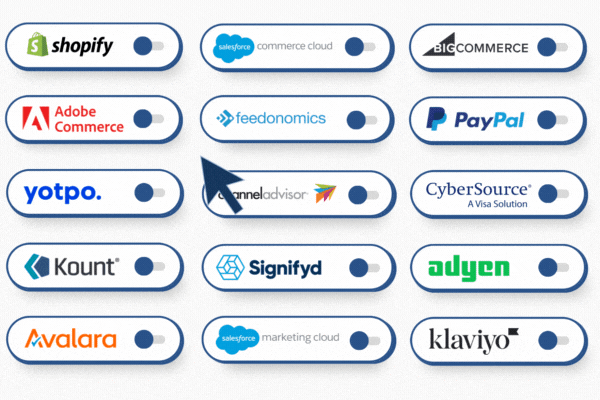
Direct-to-consumer (DTC) eCommerce continues to evolve at an unprecedented pace. Changing consumer behaviors, technological advancements, and shifting market dynamics emphasize the need for agility to stay competitive.
For DTC retail, recognizing and adapting to emerging trends is not just a growth strategy; it's a necessity for relevance and long-term success.
As consumers become more discerning and expectations rise, consumer brands must innovate to meet demands, create value, and deliver exceptional experiences. Identifying and integrating these trends into business operations can be the difference between leading the market and playing catch-up.
This blog explores the significant DTC trends currently shaping the eCommerce sector and provides insight into how retailers can and should adapt.
Let’s dive into the first of eight distinct DTC retail trends.
#1. Personalization & Customer Experience in DTC Models
![]()
The drive towards more tailored shopping experiences reflects a deeper understanding of customer needs and behaviors facilitated by advanced technologies and data analytics.
Brands that excel in offering personalized, customer-centric experiences are more likely to build lasting relationships, foster loyalty, and drive repeat business, setting themselves apart in the crowded eCommerce space.
AI-Driven Recommendations
AI and machine learning tools are making it easier than ever to analyze vast datasets to understand individual customer behaviors, preferences, and engagement patterns. Properly implementing analysis tools enables the delivery of personalized product recommendations that will resonate with customers.
Predictive Personalization
Taking a page from the success of companies like Stitch Fix, DTC businesses can employ AI and machine learning to curate personalized subscription packages or services.
This model analyzes customer preferences, past purchases, and even social media activity to handpick items that align with individual tastes and needs.
Popular Personalization Strategies
By incorporating AI-powered strategies, brands can create a more personalized and engaging customer experience. Here are several examples where personalization works well.
- Dynamic Content Personalization: Customize website and app content dynamically for each visitor based on their interaction history.
- Personalized Email Campaigns: Use AI to segment customers effectively and send highly targeted email campaigns.
- Customer Journey Optimization: Implement AI-driven analytics to map and understand various customer journey paths, and then optimize these paths to improve engagement and conversion rates.
- Behavioral Retargeting: Implement retargeting campaigns that reflect the individual’s browsing and shopping behavior.
- Loyalty Program Customization: Design loyalty programs with personalized rewards and experiences based on customer activities and preferences.
- Predictive Reordering: Use purchasing patterns to predict when customers will need a product replenished and prompt timely reorders.
- Location-Based Personalization: Based on the customer's geographic data, offer location-specific content, deals, and product suggestions.
- Personalized Pricing Offers: Implement dynamic pricing strategies that offer special deals based on customer loyalty and purchasing history.
- User-Generated Content Promotion: Showcase and recommend products based on user-generated content like reviews and photos from customers with similar profiles.
- In-App Personalization: Customize the user experience within mobile apps based on user behavior and preferences.
#2 Mobile Commerce & Social Selling

The widespread use of smartphones and tablets for online shopping has coined a new term in an industry already cluttered with acronyms–mobile commerce (m-commerce). While it may sound gimmicky, this shift has prompted brands to refine their mobile strategies, ensuring they effectively capture and engage the mobile-centric consumer.
Enhancing Mobile User Experience (UX)
Creating a mobile-first shopping experience goes beyond responsive design; it's about crafting an environment that's intuitive, fast, and tailored to the on-the-go consumer.
Here’s what to prioritize:
- Streamlined Navigation and Speed: Design websites and apps with the mobile user in mind, featuring user-friendly menus, quick load times, and streamlined checkout processes. This minimizes frustration and cart abandonment, enhancing the overall user experience. Incorporate features like estimated delivery dates and real-time inventory levels to keep customers informed and engaged.
- Localized Shopping Options: Utilize an order management system to showcase items available for pickup in nearby stores, offering options like Buy Online, Pick Up In-Store (BOPIS), or curbside pickup. This personalizes the shopping experience and meets the growing demand for convenience and immediacy in the mobile shopping journey.
- Personalized Interfaces: Leveraging data analytics, brands can create personalized mobile experiences that cater to individual user preferences, showing tailored product recommendations, content, and offers.
Influencer Marketing Partnerships in Mobile Commerce
Collaborating with social media influencers can significantly amplify a brand's presence and credibility on mobile platforms. Influencers can create relatable content that resonates with their followers, driving authentic engagement and directing traffic to mobile shopping platforms.
This strategy can introduce products to a target audience in a contextually relevant manner through genuine endorsements, encouraging followers to explore and purchase via mobile.
Mobile-Exclusive Offers
Many brands are developing exclusive offers and features for mobile users to incentive engagement.
Here’s how and why:
- App-Only Discounts and Promotions: Special offers available only through the mobile app can encourage downloads and regular engagement, boosting mobile sales and customer loyalty.
- Early Access Features: Providing mobile users with early access to sales, new products, or special content can enhance the value of the mobile experience and foster brand loyalty.
Voice Commerce: The Next Frontier
As voice-assisted devices like Alexa, Google Assistant, and Siri become more common in households, their use extends beyond basic queries to include shopping activities. People increasingly use these devices to ask about products, compare prices, and even make purchases directly through voice commands.
- Voice-Activated Shopping: Integrating voice recognition technology allows consumers to search for products, add them to the cart, and make purchases hands-free, offering a convenient and innovative shopping experience.
- Optimization for Voice Search: To capitalize on voice search, brands are optimizing their mobile platforms for voice search, focusing on natural language processing and context-driven search queries to meet the unique demands of voice-activated shopping.
#3 Flexible Payment Options

The adoption of Buy Now Pay Later (BNPL) and digital wallets reflects a broader shift towards more flexible, secure, and consumer-friendly payment options. To stay ahead, DTC brands must ensure their technology infrastructure supports various payment options and allows for the easy addition or modification of payment strategies as market demands change.
Buy Now Pay Later
BNPL services have revolutionized the online shopping experience, allowing consumers to purchase products immediately and pay for them over time, often interest-free. This payment model has gained immense popularity due to its flexibility and affordability.
Here are some of the benefits for brands implementing BNPL:
- Consumer Appeal: BNPL options cater to budget-conscious consumers, particularly millennials and Gen Z shoppers, by offering a more manageable way to spread the cost of purchases. This can increase cart sizes and higher conversion rates for DTC brands.
- Storefront & OMS Integration: For DTC retailers, integrating BNPL solutions into their checkout process is straightforward, with many payment providers offering easy-to-implement solutions that can enhance the customer experience.
- Impact on Purchasing Decisions: BNPL can influence consumer purchasing decisions, encouraging shoppers to buy higher-priced items or add additional products to their cart, knowing they can pay in installments without immediate financial strain.
Digital Wallets
Digital wallets, like Apple Pay, Google Wallet, and Samsung Pay, offer a secure and convenient way for consumers to store payment information and complete transactions quickly.
Enabling payments through digital wallets should be a priority. Here’s why:
- Enhanced Security: With advanced encryption and tokenization, digital wallets provide a secure way to conduct transactions, reducing the risk of fraud and data breaches. This security aspect particularly appeals to consumers increasingly concerned about online privacy.
- Mobile Shopping Optimization: As mobile commerce grows, digital wallets are becoming the preferred payment method for many mobile shoppers due to their convenience and speed. A simple tap or fingerprint authentication can finalize a purchase, streamlining the mobile shopping experience.
Support For Split Payment Options
![]()
- Flexible Payment Infrastructure: An Order Management System (OMS) that can handle multiple payment methods, including BNPL, digital wallets, traditional credit/debit card payments, and emerging payment forms, is essential. This flexibility empowers brands to adapt quickly to new payment trends and consumer expectations.
- Gift Card Integrations & Payment Splitting: Enabling payment splitting between gift cards and other payment methods can enhance the customer experience. Consumers appreciate the flexibility to use multiple payment sources in a single transaction, such as applying a gift card and covering the remaining balance with another payment type.
#4 Subscription Models & Loyalty Programs
DTC brands that combine subscription models with dynamic loyalty programs are poised to create compelling value propositions for their customers.
This will ultimately lead to increased customer lifetime value, enhanced brand loyalty, and a stronger competitive position in the eCommerce marketplace.
Subscription Models: Ensuring Recurring Revenue
Subscription services have transformed consumers' interactions with brands, offering convenience and personalized experiences.
Here’s how they're evolving:
- Curated experiences: Curated Experiences: Beyond just delivering products, subscriptions now offer curated experiences that resonate with the lifestyles and values of consumers.
- Flexibility and Control: Modern subscribers demand flexibility in their subscriptions. Brands are responding by allowing customers to pause, skip, or customize their subscription intervals and contents, giving consumers more control over their experience and expenditure.
Loyalty Programs That Go Beyond Points & Discounts
Loyalty programs that transcend traditional points and discounts offer a unique brand experience, fostering long-term customer engagement. For retailers implementing such programs, a system that accurately tracks loyalty points is crucial to ensure consistency and trust, especially during product returns.
Tiered Rewards Systems
Implementing tiered rewards structures incentivizes continued engagement, with higher tiers offering more exclusive benefits, such as early access to new products, special events, or personalized services.
Personalized Rewards
Loyalty rewards are increasingly personalized, with offers and perks tailored to individual customer preferences and purchasing history. For example, a beauty brand might offer special rewards in product categories that customers frequently purchase.
Community & Brand Advocacy
Loyalty programs are evolving to include elements of community building and brand advocacy. Customers can earn rewards for leaving reviews, referring friends, or participating in brand-sponsored social initiatives, thus deepening their emotional connection with the brand.
#5 Omnichannel and Flexible Fulfillment
The rise of omnichannel retailing and the demand for flexible fulfillment options are shaping how DTC brands meet consumer expectations for convenience, speed, and flexibility.
What Tech is Needed to Power Omnichannel Fulfillment Models?
An Order Management System (OMS) is crucial in enabling these fulfillment models, acting as the backbone that supports the seamless integration of various sales and distribution channels.
Buy Online, Pick Up In-Store (BOPIS)
BOPIS has become a consumer favorite, blending online shopping convenience with the immediacy of in-store pickup. An OMS orchestrates this by syncing online orders with physical inventory, ensuring products are reserved and ready for customer pickup promptly.
Ship-from-Store
Brick-and-mortar store locations can double as fulfillment centers, shipping orders directly to customers. The ship-from-store model reduces shipping times and costs. An OMS manages this by determining which stores have the inventory to fulfill online orders efficiently, turning brick-and-mortar assets into valuable e-commerce resources.
Curbside Pickup
To meet the demand for convenience and safety, curbside pickup allows customers to collect their purchases without entering the store. An OMS coordinates order preparation and customer notifications, ensuring a smooth and quick pickup process.
Same-Day & Next-Day Delivery
Speed is a critical factor in customer satisfaction. An OMS enables real-time inventory visibility and logistics coordination, facilitating rapid order processing and delivery to meet customer expectations for quick service.
Buy Online, Return In-Store (BORIS)
BORIS allows customers who have made online purchases to return them at a physical store location. This model enhances customer convenience by providing a straightforward return process and immediate resolution.
An OMS better enables BORIS by tracking returns in real time, updating inventory levels accordingly, and processing refunds or exchanges efficiently. This improves the customer experience and also helps retailers manage returns more effectively, reintegrating returned products into the inventory system quickly to minimize loss.
#6 Direct-to-Consumer Expansion and Marketplaces

DTC brands continue to carve out significant market share, driven by the expansion into new markets and leveraging online marketplaces as strategic channels for growth and lower customer acquisition costs.
The dynamic interplay between direct-to-consumer strategies and marketplace presence is key to broadening their reach, enhancing customer experiences, and achieving sustainable growth.
Here’s where expansion trends are most notable.
Expansion into New Markets
Many notable DTC companies are looking beyond their traditional customer bases and geographic boundaries, exploring new markets to tap into unmet demands and diversify their revenue streams.
- Global Reach: Logistics and digital marketing advancements have made international expansion more accessible. Brands can now more easily reach customers worldwide, adapting their offerings to local tastes, preferences, and regulatory requirements.
- Niche Market Exploration: This involves identifying specific, often underserved market segments and creating new brands or sub-brands to cater to these groups. This approach allows companies to focus intensely on a targeted audience's unique needs and preferences, offering specialized products or services designed just for them.
Leveraging Online Marketplaces
Listing products on well-known marketplaces like Amazon, eBay, Facebook, and TikTok Shop can significantly boost visibility, attract a larger customer base, and drive sales. These channels are especially beneficial for newer brands looking to establish credibility and gain exposure quickly.
Marketplaces offer valuable data and insights that DTC brands can use to understand market trends, consumer behavior, and the competitive landscape. This information can inform product development, pricing strategies, and marketing campaigns.
Integrating Marketplaces with DTC Strategies
To maximize the benefits of both direct and marketplace selling, DTC brands are adopting integrated strategies that leverage the strengths of each channel.
- Coordinated Inventory and Order Management: Utilizing an Order Management System (OMS) allows brands to synchronize inventory and order processing across their DTC website and marketplace platforms, ensuring consistency and efficiency in fulfillment.
- Unified Brand Experience: Maintaining a consistent brand experience is crucial even when selling on external marketplaces. DTC brands should ensure that product quality, customer service, and brand messaging are coherent across all channels.
- Data-Driven Decision-Making: The combination of direct consumer interactions and marketplace analytics provides a rich data source for strategic decision-making. Brands can use this data to refine their marketing strategies, product offerings, and customer service practices, aligning them with consumer needs and preferences.
#7 Sustainable eCommerce Practices
DTC brands are increasingly prioritizing sustainability in their sourcing strategies, opting for environmentally responsible materials and products.
The shift towards sustainability also extends to packaging and shipping, where brands find innovative ways to reduce waste and emissions.
Here’s a closer look.
Sustainability Practices |
|
|
Sourcing Sustainable Materials |
Selection of renewable, recycled, or biodegradable materials for products and packaging to reduce environmental impact. |
|
Ethical Supply Chains |
Collaboration with suppliers who practice sustainable and ethical production methods. |
|
Minimalist Packaging |
Simplified packaging designs that use fewer materials, lowering shipping costs and carbon emissions. |
|
Eco-friendly Shipping Options |
Providing options like consolidated shipping or carbon-neutral delivery to lessen logistics' environmental impact. |
How an OMS Empowers Sustainable Operations
An Order Management System (OMS) can be a powerful tool for implementing and managing sustainable practices effectively.
- Efficient Shipping: An OMS optimizes packing and shipping processes, ensuring that orders are fulfilled in the most efficient way possible. By analyzing order data, the system can determine the best shipping methods to minimize waste and reduce last-mile delivery costs.
- Streamlined Returns: The OMS can facilitate a more efficient returns process, reducing the need for excess shipping and handling that contributes to increased carbon emissions. Streamlined returns also allow for quicker restocking and resale of returned items, reducing waste.
- Inventory Optimization: An OMS helps prevent overproduction and excess stock by providing real-time visibility into inventory levels across all channels, aligning inventory management with demand to avoid unnecessary waste.
- Localized Fulfillment: Utilizing an OMS to manage inventory in localized fulfillment centers as well as offering self pickup options like BOPIS and Curbside Pickup can reduce the distance products travel to reach customers, lowering transportation costs and emissions.
- Route Optimization: An OMS can help plan the most efficient delivery routes, reducing fuel consumption and emissions associated with last-mile delivery.
#8 Tech Stacks Built Around Composable Commerce

Composable commerce is about building a flexible and scalable tech stack that comprises best-in-class solutions, allowing brands to select and integrate the most suitable technologies for their specific needs.
The emphasis on customization and scalability enables brands to tailor their tech stack to fit their unique business model and scale components as they grow, ensuring that the technology evolves in tandem with the business.
Best of all, with the right tech in place, brands can quickly adopt new technologies and adapt to emerging trends without overhauling their entire systems. This flexibility is crucial in responding to market dynamics, consumer behavior shifts, and competitive pressures.
The Role and Benefits of an Order Management System in Composable Commerce
An Order Management System (OMS) is a cornerstone in the composable commerce ecosystem. It provides the necessary infrastructure to streamline operations and enhance customer experiences.
Centralized Order and Inventory Management
An OMS acts as the nerve center in a composable commerce architecture, centralizing order processing, inventory management, and fulfillment across various channels and touchpoints, thus ensuring consistency and efficiency.
Seamless Integration with Other Systems
The strength of an OMS in a composable commerce setup lies in its ability to integrate seamlessly with other systems, whether it's eCommerce platforms, CRM tools, payment gateways, loyalty programs, deferred payment programs, or shipping and logistics solutions. This interoperability allows for a cohesive and unified tech stack that drives operational excellence.
Cost Effective & Time Efficient
Instead of investing in monolithic systems that may become quickly outdated, composable commerce enables brands to invest in specific areas that need enhancement or upgrading, saving time and resources while staying on the cutting edge.
Agile Response to Consumer Trends
Whether embracing AI-driven personalization, tapping into mobile commerce innovations, or adopting sustainable practices, a composable commerce approach allows DTC brands to quickly integrate new functionalities and stay ahead of consumer trends.
Want to See More DTC Trends? Check Out the Latest Episode of Covering Commerce
How Deck Commerce Gives DTC Brands a Competitive Edge
Deck Commerce is the only Order Management System specifically crafted specifically for DTC brands, boasting over 60 integrations with leading commerce vendors. By leveraging Deck Commerce, brands can adeptly navigate the ever-evolving DTC landscape, staying ahead of trends and adapting to the dynamic market shifts anticipated this year.
Ready to enhance your brand's efficiency and market presence? Discover how Deck Commerce can streamline your operations and support your growth. Contact us to learn more about leveraging our OMS for your business success.

